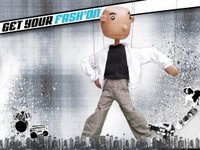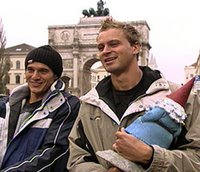Bad Ads: Televisionary Rants About Irritating TV Series One Sheets
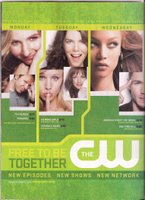 It's that time of year again when the kids start heading back to school, FOX starts unveiling new series that it will only cancel a few episodes down the line, and the fall television season begins anew. It's a magical time this year when we're faced with an onslaught of new and flashy series and a flashy new network, even. (Hullo, CW!)
It's that time of year again when the kids start heading back to school, FOX starts unveiling new series that it will only cancel a few episodes down the line, and the fall television season begins anew. It's a magical time this year when we're faced with an onslaught of new and flashy series and a flashy new network, even. (Hullo, CW!)It's also that time when the billboards and bus stations, not mention certain entertainment-oriented publications, around you seem to be suddenly occupied with imagery from those upcoming programs... and if anything they're driving you NOT to watch these shows. Yes, ladies and gentlemen, I am talking about those irritatingly cloying one-sheets that the networks plaster all over town to gawk at you as you drive to work in the mornings or clutter this week's Entertainment Weekly with reams of wasted paper. Not since the talking My Name is Earl magazine inserts from last season have ads irritated me quite this much...
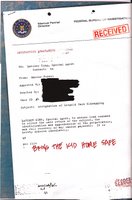 The most unintentionally funny ad has got to be the "dossier" for NBC's upcoming kidnapping drama Kidnapped that appeared in Entertainment Weekly this week. Filled with "notes" about the abduction of fabulously wealthy scion Leopold Cain, the case file prepared by FBI Agent Latimer King (Delroy Lindo) contains such fascinating and intriguing "hand-written" notes as "Highly Unorthodox and effective," in reference to Jeremy Sisto's Knapp, and "Track him 24/7." (Like an FBI agent would actually have to write that down in the file? Puhlease.) But my personal favorite has got to be at the very end of this glossy, heavy-stock "dossier": an inter-office memo to Latimer King assigning him to the Cain case, where someone (who could it be!) has scrawled "Bring the kid home safe." Gee, thanks for the genius summation of the entire series. Who would have thought that a kidnapping drama would be, you know, about getting the kid back?
The most unintentionally funny ad has got to be the "dossier" for NBC's upcoming kidnapping drama Kidnapped that appeared in Entertainment Weekly this week. Filled with "notes" about the abduction of fabulously wealthy scion Leopold Cain, the case file prepared by FBI Agent Latimer King (Delroy Lindo) contains such fascinating and intriguing "hand-written" notes as "Highly Unorthodox and effective," in reference to Jeremy Sisto's Knapp, and "Track him 24/7." (Like an FBI agent would actually have to write that down in the file? Puhlease.) But my personal favorite has got to be at the very end of this glossy, heavy-stock "dossier": an inter-office memo to Latimer King assigning him to the Cain case, where someone (who could it be!) has scrawled "Bring the kid home safe." Gee, thanks for the genius summation of the entire series. Who would have thought that a kidnapping drama would be, you know, about getting the kid back?But at least I can skip past the Kidnapped dossier. What I can't escape from are those ubiquitous green CW ads (above) with the newly minted netlet's stars in awkward poses proclaiming themselves as free to be anything from scary to fearless to fierce, all while looking uncomfortable and ridiculous. Poor Lauren Graham looks particularly ill-at-ease, with a too-tight smile plastered across her face. At least Graham's Gilmore co-star Alexis Bledel got to relax a bit. No such luck for new timeslot mate Kristen Bell, whose pose involves a cross between a shush and a kiss. Not sure what that's about, in fact. Even Bell seemed to hate the pose, which has popped up on billboards and bus shelters all over Los Angeles; she implied as much at the San Diego Comic Con back in July.
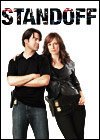 The worst of the bunch has got to be the one-sheet for FOX's new hostage drama Standoff, which depicts series leads Ron Livingston and Rosemary DeWitt in a "cheeky" pose: he arms crossed looking serious and somewhat brooding; she leaning against him, her feet slightly crossed as police caution tape tangles around their lower extremities. The entire effect looks like a seriously dated 1980s romantic comedy film and I can't look at the ad without bursting out into giggles. This is supposed to get me to tune in? It's like a ditched one-sheet for Moonlighting but without the subtext or tension. Fortunately, I've seen the pilot for Standoff, which airs tonight on FOX, and have no intention of tuning in (unlike EW, I found DeWitt to be cloying, much like the show itself, which criminally under-utilizes its costar, Gina Torres). Me, I'd just like to get through the Beverly Center without being harassed by another one of these blandly posed posters. (If anyone should stand off, it's the FOX marketing department.)
The worst of the bunch has got to be the one-sheet for FOX's new hostage drama Standoff, which depicts series leads Ron Livingston and Rosemary DeWitt in a "cheeky" pose: he arms crossed looking serious and somewhat brooding; she leaning against him, her feet slightly crossed as police caution tape tangles around their lower extremities. The entire effect looks like a seriously dated 1980s romantic comedy film and I can't look at the ad without bursting out into giggles. This is supposed to get me to tune in? It's like a ditched one-sheet for Moonlighting but without the subtext or tension. Fortunately, I've seen the pilot for Standoff, which airs tonight on FOX, and have no intention of tuning in (unlike EW, I found DeWitt to be cloying, much like the show itself, which criminally under-utilizes its costar, Gina Torres). Me, I'd just like to get through the Beverly Center without being harassed by another one of these blandly posed posters. (If anyone should stand off, it's the FOX marketing department.) Continuing this trend is the one-sheet for CBS's James Woods-starring legal procedural Shark, which depicts the famous lothario as yet another 1980s bad boy, peering over the rims of his designer sunglasses at the audience, as if to dare them to come up with a reason as to why an actor of Woods' caliber would suddenly be working on a network television series. Fellow CBS freshman series, The Class, an ensemble comedy with Jason Ritter, depicts its youthful stars in various poses, complete with hula hoops, and the catchphrase "They've got a lot to learn."
Continuing this trend is the one-sheet for CBS's James Woods-starring legal procedural Shark, which depicts the famous lothario as yet another 1980s bad boy, peering over the rims of his designer sunglasses at the audience, as if to dare them to come up with a reason as to why an actor of Woods' caliber would suddenly be working on a network television series. Fellow CBS freshman series, The Class, an ensemble comedy with Jason Ritter, depicts its youthful stars in various poses, complete with hula hoops, and the catchphrase "They've got a lot to learn."So do the people who come up with these ads, apparently. That is, if they're actually intended to make the audience tune in and not tune out.
What's On Tonight
8 pm: Big Brother: All-Stars (CBS); Fear Factor (NBC); Gilmore Girls (WB); According to Jim/According to Jim (ABC); House (FOX); Desire (MyNet)
9 pm: Rock Star: Supernova (CBS); Law & Order: Criminal Intent (NBC); Gilmore Girls (WB); According to Jim/According to Jim (ABC); Standoff (FOX); Fashion House (MyNet)
10 pm: NCIS (CBS); Law & Order: Special Victims Unit (NBC); Primetime (ABC)
What I'll Be Watching
9 pm: Eureka on Sci-Fi.
The whimsical new sci-fi drama that's more Northern Exposure than Stargate. On tonight's episode ("Right as Raynes"), a young computer programmer--the Raynes of the episode's title--returns to Eureka, trailing havoc in his wake. Sounds like another typical day in this little messed up berg.
11 pm: Love Soup on BBC America. (10 pm ET)
The whimsical British romantic drama, starring Black Books' Tamsin Greig and Lois & Clark's Michael Landes and written by Jonathan Creek creator David Renwick, returns with another new installment tonight. In tonight's episode ("War is Heck"), Alice learns that a family member is concealing a dark secret, while Gil attempts to turn his fantasies about his dentist into reality.

